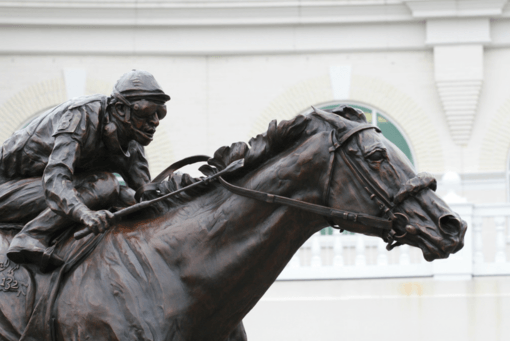
Photo by Benjamin Thomas | CC BY 2.0
This Saturday, May 5th, brings us the 144th Kentucky Derby, with the Preakness (May 19th) and Belmont Stakes (June 9th) galloping close behind.
The Kentucky Derby pits 20 horses against each other, and the owner of the fastest will collect more than a million dollars.
Gronkowski, a horse saddled with the silly name of a New England Patriots tight end, was to run on Saturday. The horse, who endured a trip to England to qualify for the Derby, reportedly has a “minor” infected head wound that led to a fever, and cannot be shipped to Louisville.
Gronkowski is owned by Phoenix Thoroughbreds, a recent arrival into what insiders call the international bloodstock scene, where buying animals is all about return on investment. No wonder the animals are kept moving with drugs.
While Gronkowski won’t bring the expected ROI this year, the horse personally misses nothing but danger.
The Other Side of the Tracks
Every year, people celebrate Derby Day with parties, mint juleps, and sunbonnets. This year they’ll be marking the tenth anniversary of the end of Eight Belles, raced to death in the 2008 Kentucky Derby.
Perhaps they’ll recall the two horses who died at the 2016 Preakness in Baltimore. Pramedya’s leg broke. And after winning the first race, Homeboykris collapsed and died before making it back to the barn.
Ten years prior, Barbaro won the 2006 Derby, but shattered a leg in the Preakness, and died soon after. Remember?
Or do we forget because the deaths are so common, so constant? Every year, 500 horses, more or less, die at a racetrack. Every year, spectators will gasp hundreds of times as they see with their own eyes that racing is animal torture.
Most racehorses who come off the track intact won’t live much longer. Some racers or jumpers die hours or days after an event, typically from leg injuries or bleeding in the lungs.
And if they do live, what kind of life will they have? Perhaps you’ve seen them dragging new owners and their merchandise along Route 30 through Amish country in rural Pennsylvania, or hauling tourists around a hectic city.
Not to mention the start of the pipeline—routine culling of unwanted young thoroughbreds. Consider that many tens of thousands of foals are born yearly to “bloodstock” worldwide, fewer than half are selected to race.
More than 100,000 thoroughbreds a year in the United States will go to killer buyers, reported Forbes in 2011. And as long as the industry exists, it will produce surplus horses. Insofar as horse slaughter is barred in the United States, the discarded horses just get shifted to hellish trips to slaughter in Mexico or Canada. The transport staff can’t use electric prods on the horses, so the Department of Agriculture says they’re getting “proper care.” Jesus wept.
A Collective Awakening
Yes, as I child I watched jumping and racing events. I unfolded scraps with names picked out of flowery hats for random bets. Who hasn’t? A race is presented as a cultural event, with a storied history. A European history, rooted in the invasions of the ancient Romans, who fancied chariot races in the circus.
Oliver Cromwell banned racing for encouraging “wicked, and secret Plots and Devices.” The wickedest plot is no secret any more. Public attitudes about animals in spectacles are changing.
I’d like to expect a collective awakening, in which we adopt the same aversion to animal racing as we have to putting bulls in rings or orcas in tanks.
I’d like to think a grown-up society would stop the purpose-breeding and use of horses, all uses of horses: racing, jumping and showing, fox hunting, barrel racing, polo, policing, dragging our stuff around town, or just having horses to show off wealth and take up 81 million acres of developed space. Let them have their own space, on their own terms.
Meanwhile, I’ll pass on the mint julep, thanks.